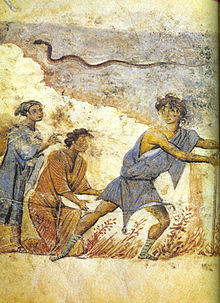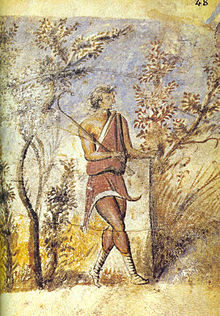

The Theriaca (Ancient Greek: Θηριακά) is the longest surviving work of the 2nd-century BC Greek poet Nicander of Colophon.
It is a 958-line hexameter poem describing the nature of venomous creatures, including snakes, spiders and scorpions, and the wounds that they inflict.
Nicander also wrote the companion work Alexipharmaca, which explored other poisons and venoms.
Etymology
The title is the Latinized form of the Greek neuter plural adjective θηριακά (thēriaka), "having to do with venomous animals", which in turn derives from Ancient Greek: θηρίον (thērion), "wild animal". A corresponding English noun, theriac, also exists.
Content
It has been noted that Theriaca is a poem not solely concerned with its intended subject matter, given its "arcane language". Nicander makes references to a drakōn, however it is likely this term is utilized to refer to an Aesculapian snake rather than a dragon in the contemporary perception of the word.
References
- "Nicander of Colophon". University of Chicago.
- θηριακός. Liddell, Henry George; Scott, Robert; A Greek–English Lexicon at the Perseus Project.
- θηρίον in Liddell and Scott.
- "theriaca". dictionary.com.
- Overduin, Floris (December 2014). "The Anti-Bucolic World Of Nicander's 'Theriaca'". The Classical Quarterly. 64 (2): 623. doi:10.1017/S0009838814000342. hdl:2066/133161. JSTOR 43905601. S2CID 170453942. Retrieved 9 May 2021.
- Senter, Phil; Mattox, Uta; Haddad, Eid. "Snake to Monster: Conrad Gessner's Schlangenbuch and the Evolution of the Dragon in the Literature of Natural History". Journal of Folklore Research. 53 (1): 74. doi:10.2979/jfolkrese.53.1-4.67. S2CID 163428518. Retrieved 25 March 2021.
Further reading
- Weitzmann, Kurt, ed., Age of spirituality: late antique and early Christian art, third to seventh century, no. 226, 1979, Metropolitan Museum of Art, New York, ISBN 9780870991790; full text available online from The Metropolitan Museum of Art Libraries
This article related to a poem is a stub. You can help Misplaced Pages by expanding it. |
This ancient Greece–related article is a stub. You can help Misplaced Pages by expanding it. |